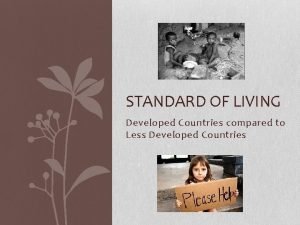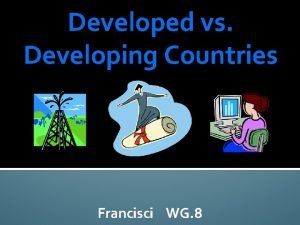Economic Development Keywordsphrasesconcepts LEDC Less Economically Developed Countries

- Slides: 1

Economic Development Keywords/phrases/concepts LEDC Less Economically Developed Countries – old term MEDC More Economically Developed Countries – old term LIC Lower Income Countries – where GNI/head <$400 & Qo. L is low e. g. Afghanistan, Somalia, Uganda, Nepal HIC Higher Income Countries – where GNI/head is >$12, 000 & Qo. L is high e. g. UK, USA, Germany, France NEE Newly Emerging Economies – BRIC/MINT countries – economy moving from mainly Primary to Secondary & Qo. L is increasing. e. g. Brazil, China, Turkey, Mexico, Indonesia Demographic Transition Model (DTM) • • • Causes of Uneven Development Shows how changing birth & death rates affect population growth. Has five phases (used to have four), which are linked to a country’s level of development. Birth Rate higher than Death Rate = Population (Natural) Increase Death Rate higher than Birth Rate = Population (Natural) Decrease Population of a country changes over time as it develops. Indicators Gross National Income (GNI) Total value of goods & services produced by a country, incl income from overseas. In US$. Measure of WEALTH. As country develops it gets HIGHER. E. g. Afghanistan=$1. 9 k; Mexico=$18. 9 k; UK=42. 5 k Gross Domestic Product (GDP) Total value of goods & services produced in a year – does not include overseas income. US$. Measure of WEALTH. As country develops it gets HIGHER. Birth rate Number of live babies born per year. Expressed as per thousand of population. Measure of WOMEN’S RIGHTS. As country develops it gets LOWER. e. g. Afghanistan=38/’ 000; Mexico=18/’ 000; UK=12/’ 000 Infant Mortality Rate Number of babies who die before 12 months. Expressed as per thousand babies born. Measure of HEALTH. As country develops it gets LOWER. e. g. Afghanistan = 113/’ 000; Mexico=12/’ 000; UK=4/’ 000 Death Rate Number of deaths. Expressed as per thousand of population. Measure of HEALTH. As country develops it gets LOWER. e. g. Afghanistan = 13. 4/’ 000; Mexico=5. 3/’ 000; UK=9. 4/’ 000 People per Doctor The average number of people per doctor. Measure of HEALTH. As country develops it gets LOWER. E. g. Afghanistan=0. 3/’ 000; Mexico=2. 1/’ 000; UK=2. 8/’ 000 Literacy Rate The percentage of adults who can read & write. Measure of EDUCATION. As country develops it gets HIGHER. E. g. Afghanistan=38. 2%; Mexico=94. 5%; UK=99% Access to safe water The percentage of population who can get clean drinking water. Measure of HEALTH. As country develops this gets HIGHER. E. g. Afghanistan=55%; Mexico=96. 1%; UK=100% Life Expectancy The average a person is expected to live. Measure of HEALTH. As country develops it gets HIGHER. Afghanistan=51 yrs; Mexico=75. 9 yrs; UK=80. 7 yrs BUT! Using one measure on its own can be misleading as there can be differences in the rate each measure improves. So best indicator is HDI. Human Development Index (HDI) Impacts of Uneven Development Stage 1 • Least developed. • No population growth & pop’n is low and steady. • High BR (& fluctuating) as no use of contraception & large families due to high IMR. • High DR (& fluctuating) due to poor healthcare/ famine/war. • LE is low. • GNI is very low. e. g. No countries now, but some Amazon tribes. Stage 2 • Not very developed. • Population growth very high & total population increasing rapidly. • Economy based on agriculture. • High & steady BR as no use of contraception & large families due to high IMR/need to work on the land. • Falling rapidly DR due to improved healthcare & diet. • LE is increasing. • GNI still low e. g. Gambia (HDI = 0. 4). Stage 3 • More developed, includes many NEEs. • Population growth high & population increasing. • Economy moving to Secondary manufacturing. • Rapidly falling BR due to better equality and education, and less need for children to work in farming. • Slowly falling DR. • LE increases due to healthcare. • GNI is growing. e. g. India (HDI = 0. 8) Stage 4 • Most developed. • Population high and steady with no growth. • Economy in Tertiary and Quaternary sectors. • Low, fluctuating BR as people pursue careers & possessions plus elderly care. • Low, fluctuating DR • LE is high • GNI is high. e. g. UK (HDI = 0. 9) Stage 5 • Most developed. • Population slowly falling with negative growth. • Economy in Tertiary and Quaternary sectors. • Slowly falling BR. • Low &steady DR. • LE is high. • GNI is high e. g. Japan (HDI = 0. 9). Calculated using Life Expectancy, Average Number of Years Schooling (Education Level) & Income per Head. Values between 0 (least developed) and 1 (most developed). Afghanistan= 0. 48; Mexico= 0. 76; UK= 0. 91 Trans. National Corporations (TNCs) Physical • Poor climate – too hot (Chad) or too cold to grow food. • Poor agricultural land – too steep, poor soils. • Few raw materials – less products to sell, or don’t have infrastructure to extract the raw materials. • Natural hazards – floods etc – money spent repairing damage and not invested. Historical • Former colony – coloniser took raw materials/didn’t invest in infrastructure. • Conflict – civil wars, long running tribal wars. Economic • Debt. • Poor trade links – small volume with small number of ‘customers’. • Economy based on primary products – profit low and few opportunities to add value. Often at risk of world market fluctuations. • Create jobs in countries they’re located in. • Company located/produce products in/sell in more than one country. • Employees in poorer countries get regular income. • Factories usually located in poorer countries where land/labour is cheaper • TNCs may spend money to improve infrastructure & facilities e. g. rods, ports, airports and regulations may not be as high = more profit. BUT this is primarily to benefit them. • HQs usually located in HICs where more skilled people with administration • New technology & skills brought to poorer countries. skills. Wealth – lower GNI and less to invest in infrastructure. Health – due to less money, likely to be less access to healthcare = lower LE, higher DR & IMR. International migration – people move to neighbouring HICs as see more opportunities, especially younger people = drain of labour resource. Strategies to reduce Development Gap Aid – to be spent on infrastructure projects to increase Qo. L/health/ education. BUT can be lost through corruption or is not sustainable (when money stops, project stops). Debt Relief Fair Trade – buyers have to pay producers a ‘fair’ price, plus develop infrastructure/education etc. Is sustainable and aim is to make producers sustainable. Investment – Foreign Direct Investment (FDI) by TNCs is buying property or infrastructure in another country, can lead to improved skills & infrastructure. Industrial Development – in economy based mainly in primary sector, developing industry can generate increased income (through value add) which can increase GNI and Qo. L. Microfinance – small scale loans given to those who may not get credit so can start own business. Does work for some people but not clear it can have large-scale effect on poverty. Use of Intermediate Technology – tech that is cheap to buy & simple to use and maintain. Tourism – increases income coming in to a country. BUT usually only small &age of income goes to locals; often operators are based in HICs so benefit does not go to LIC; potentially environmental damage due to vehicles/ships; • Employees in poorer countries paid less than those in richer countries ad may have to work longer hours in poor conditions. • Profits made by TNCs go back to the richer countries where they have HQ – NOT invested in the poorer countries. • Jobs created in poorer countries not secure as TNC may move.

